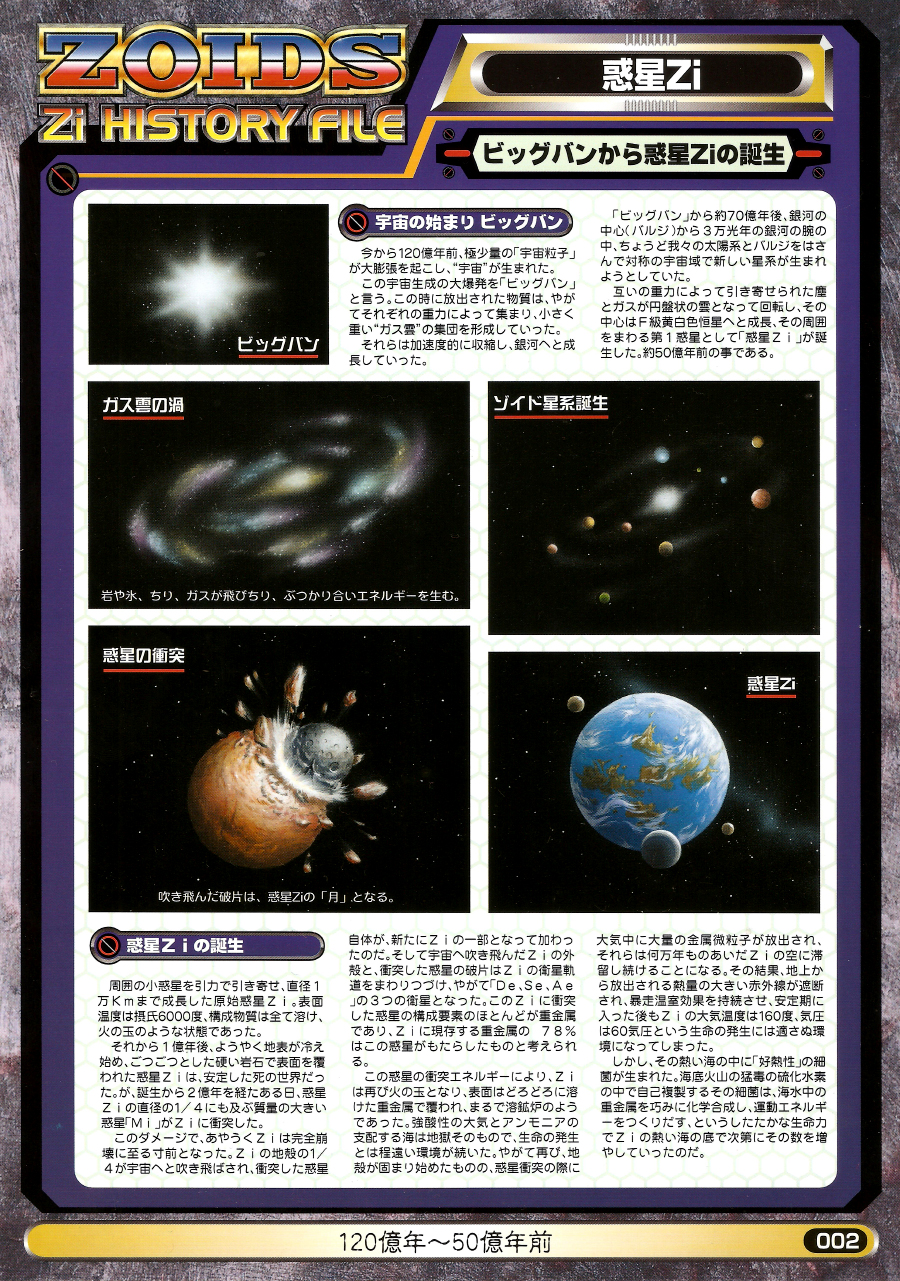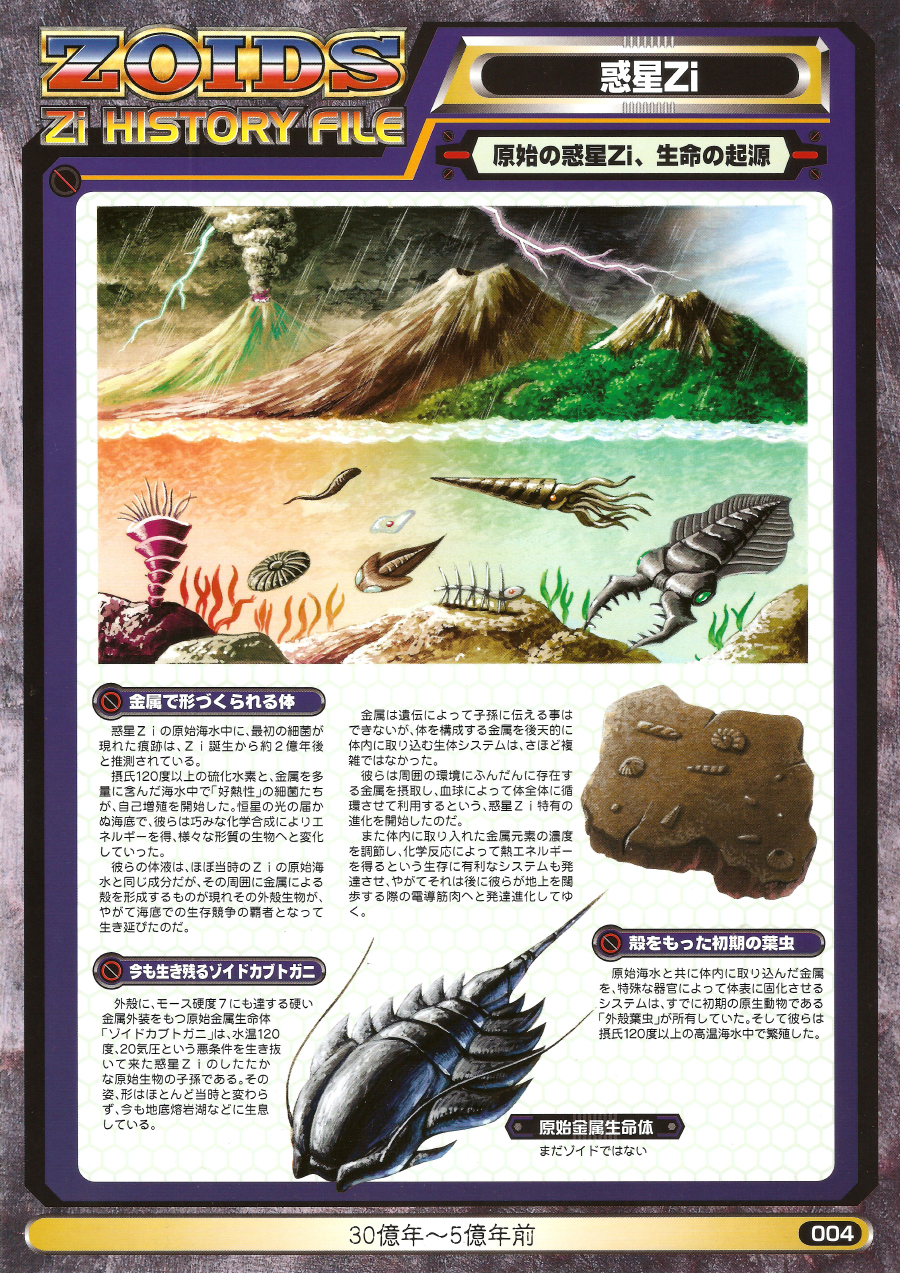
- Planet Zi
From the Big Bang to the Birth of Planet Zi
 The Beginning of the Universe: The Big Bang
The Beginning of the Universe: The Big Bang
12 billion years ago, a miniscule amount of "cosmic particles" caused a major expansion, and the "universe" was born.
This huge explosion that created the universe is called the "Big Bang". The matter released at this time eventually gathered together due to its own gravity, forming groups of small, heavy "gas clouds".
These contracted at an accelerating rate and grew into galaxies.
About 7 billion years after the Big Bang, in a galactic arm 30,000 light years from the centre (or "bulge") of the Milky Way, in a symmetrical region of space directly across the bulge from our own solar system, a new star system was about to be born.
Dust and gas drawn together by gravity formed a disc-shaped cloud and began to rotate. The centre grew into an F-class yellow-white star, and "Planet Zi" was born as the first planet orbiting around it. This occurred approximately 5 billion years ago.
- Diagram
 |
 |
| Vortex of Gas: Rocks, ice, dust, and gas collide and produce energy. | Planetary Collision: The broken pieces are fragments of Planet Zi's moon. |
 |  |
| The Zoid Galaxy is born. | Planet Zi. |
- The Birth of Planet Zi
The protoplanet Zi drew in nearby asteroids through gravitational attraction, growing to a diameter of 10,000 kilometres. It was in a fireball-like state, with its surface temperature at 6000 degrees Celsius and all its component matter molten.100 million years later, the ground finally began to cool, and with its surface covered in hard, jagged rocks, Planet Zi was a stable, dead world. But one day, 200 million years after its birth, the massive planet "Mi", which was as much as a quarter of Planet Zi's diameter, collided with Zi.
Due to the damage, Zi was on the verge of complete collapse. A quarter of Zi's crust was blasted off into space, and the colliding planet itself was added as a new part of Zi. In addition, the parts of Zi's crust that had been blasted into space and the fragments of the colliding planet continued to follow a satellite orbit around Zi, eventually becoming the three natural satellites "De", "Se" and "Ae". Most of the constituent elements of this planet that collided with Zi were heavy metals, and it is thought that 78% of the heavy metals currently existing on Zi were brought by this planet.
Due to the collisional energy of this planet, Zi once again became a fireball, and its surface was covered with molten heavy metals, as if it were a blast furnace. Its strongly acidic atmosphere and ammonia-dominated seas were hell incarnate, and its environment continued to be far from suitable for the origin of life. Although the planet's crust eventually began to solidify again, large quantities of minute metal particles had been released into the atmosphere during the planetary collision, and these remained in the skies of Zi for countless millennia. As a result, the high-temperature infrared rays emitted from the surface were intercepted, causing a lasting runaway greenhouse effect, and even after it entered a stable period, Zi had an atmospheric temperature of 160 degrees and a pressure of 60 atmospheres, an environment unsuited to the origin of life.
However, "thermophilic" bacteria were born in its hot seas. These bacteria self-replicated within the toxic hydrogen sulphide of submarine volcanoes, and cleverly chemosynthesised the heavy metals in the seawater to produce movement energy. With this tough life force, they gradually built up their numbers in the depths of Zi's hot seas.
The Zoid Star System's Second Planet, "Zi"
- Planet Zi's Three Satellites

The three satellites produced by the collision of the planet Mi are called "De", "Se" and "Ae", from the innermost out.
They are each collections of fragments of Zi and Mi, but the largest, Ae, is unusually massive and traces a non-concentric orbit. 100% of its constituents are considered to be fragments of Mi's satellite "Te", and by investigating the depths of Ae, there is a possibility that the mysteries of the birth of life on Zi may be elucidated. In addition, the smallest, De, has an average distance from Zi of only 180,000 kilometres, and this distance is decreasing day by day, so it is clear in theory that it will at some point fall onto Zi in 20,000 years' time.
The Zoid Star System's Second Planet
Planet Zi was born as the first planet of the Zoid Star System, but at present, another planet exists inside its orbit, and Zi revolves around an F-class yellow-white star at an average speed of 101,326 km/h as its second planet. Zi's diameter is 10,026 kilometres, and its axial inclination is 26.3 degrees.
Thermophilic" lifeforms, thought to have originated 200 million years after the planet's birth, later spread throughout the oceans of Zi.
Zi's surface, which was once an entirely molten sea of metal, eventually cooled, hardened and stabilised, divided into a solid continent and a hot ocean containing large quantities of metals.
- Planet Zi's World Map

The present surface environment and geological features of Zi were determined by the fall of a group of planetesimals onto the planet's surface 700,000 years ago. This phenomenon occurred because Zi's orbit overlaps with the orbit of a cluster of more than 100 million planetesimals, which were left behind in the process of the Zoid Star System's formation. Eight planetesimals, the largest having a radius of 16.2 kilometres and an estimated mass of 1.0008 trillion tons, fell onto the equator of Zi.
The large quantities of water brought by these planetesimals, which were lumps of rock and ice, evaporated. It washed all of the metal particles remaining in the atmosphere onto the surface, converting the atmosphere into the present Earth-type atmosphere over 20,000 years.
As a result, the thick heat-carrying clouds of metal particles disappeared, the light of the sun reached the planet's surface, and coupled with the quietening of the submarine volcanoes, the surface cooled rapidly.
The single continent was submerged by seawater brought by the planetesimals. The five current continents were formed due to differences in elevation.
5 Billion Years Ago
Primeval Planet Zi and the Origins of Life

Bodies Formed of Metal
The traces of the first bacteria appearing in the primeval seawater of Planet Zi are conjectured to be from approximately 200 million years after the birth of Zi.In seawater containing large quantities of metals and hydrogen sulphide at more than 120 degrees Celsius, "thermophilic" bacteria began to self-propagate. At the bottom of the sea where the sun's light did not reach, they gained energy through clever chemosynthesis, and transformed into creatures with a variety of characteristics.
Their bodily fluids had almost the same composition as the primeval seawater of Planet Zi at the time, but creatures appeared that formed shells using the metal in their surroundings, and these shelled creatures eventually lived on as the champions in the struggle for survival at the bottom of the sea.
Metal cannot be passed on to one's descendants genetically, but the biological system of bringing in metal to compose their bodies a posteriori was not particularly complex.
They began an evolutionary path unique to Planet Zi, absorbing the metals that existed in abundance in the surrounding environment, circulating them through their entire bodies by way of blood cells, and putting them to use.
They also developed a system advantageous to survival, regulating the concentration of metallic elements that they took into their bodies and gaining heat energy through chemical reactions, and this eventually developed into conductive muscles when they later strode onto land.
The Zoid Horseshoe Crab, Still Alive Today
 The "Zoid Horseshoe Crab", a primeval metal lifeform whose shell is a hard metal exterior reaching a Mohs hardness of 7, is a descendant of the tough primeval creatures of Planet Zi, which survived the unfavourable conditions of water at 120 degrees and 20 atmospheres. Its shape and form are almost unchanged from that time, and it inhabits underground lava lakes even now.
The "Zoid Horseshoe Crab", a primeval metal lifeform whose shell is a hard metal exterior reaching a Mohs hardness of 7, is a descendant of the tough primeval creatures of Planet Zi, which survived the unfavourable conditions of water at 120 degrees and 20 atmospheres. Its shape and form are almost unchanged from that time, and it inhabits underground lava lakes even now.
Primitive Example
These aren't Zoids yet.
Early Lobites With Shells
 The "shelled lobites", early protozoans, already possessed a system to take metals into their body along with primeval seawater and solidify them on their body's surface using special organs. And so, they propagated in the high-temperature seawater at more than 120 degrees Celsius.
The "shelled lobites", early protozoans, already possessed a system to take metals into their body along with primeval seawater and solidify them on their body's surface using special organs. And so, they propagated in the high-temperature seawater at more than 120 degrees Celsius.
3 Billion ~ 500 Million Years Ago
- Navigation



You can go back to the home page for The Zoids Bible to view a thumbnail gallery of all of the pages.
- Page Scans



Differences in the Monthly Zoids Graphics
There were quite a few differences between the Zoids Bible, printed and released through the Zoid Core Box, and the Monthly Zoids Graphics, which included pages from the Bible. We'll go through and list those below. The differences are in a bold, italic font.
- Differences
Original Text:| They are each collections of fragments of Zi and Mi, but the largest, Ae, is unusually massive and traces a non-concentric orbit. 100% of its constituents are considered to be fragments of Mi's satellite "Te", and by investigating the depths of Ae, there is a possibility that the mysteries of the birth of life on Zi may be elucidated. In addition, the smallest, De, has an average distance from Zi of only 180,000 kilometres, and this distance is decreasing day by day, so it is clear in theory that it will at some point fall onto Zi. |
They are each collections of fragments of Zi and Mi, but the largest, Ae, is unusually massive and traces a non-concentric orbit. 100% of its constituents are considered to be fragments of W, and by investigating its ? (gamma), the day may come when the mysteries of the birth of life on Zi are elucidated. In addition, the smallest, De, has an average distance from Zi of only 180,000 kilometres, and this distance is decreasing day by day, so it is clear in theory that it will fall onto Zi in 20,000 years' time.

Original Text:
| As a result, the thick heat-carrying clouds of metal particles disappeared, the light of the sun reached the planet's surface, and coupled with the quietening of the submarine volcanoes, the surface cooled rapidly. The single continent was submerged by seawater brought by the planetesimals. The six current continents were formed due to differences in elevation. |
As a result, the hot clouds of metal particles disappeared, the light of the sun reached the planet's surface, and coupled with the quietening of the submarine volcanoes, the surface cooled rapidly. The single continent was submerged by seawater brought by the planetesimals. The five current continents were formed due to differences in elevation.

Original Text:
| The traces of the first bacteria appearing in the primeval seawater of Planet Zi are conjectured to be from approximately 200 million years after the birth of Zi. |
The traces of the first bacteria appearing in the primeval seawater of Planet Zi are conjectured to be from approximately 20 thousand years after the birth of Zi.







